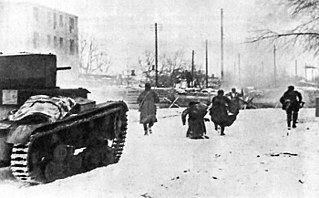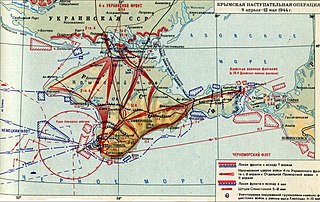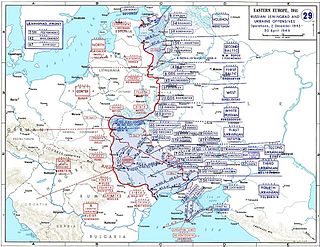
Hermann Hoth was a German army commander, war criminal, and author. He served as a high-ranking panzer commander in the Wehrmacht during World War II, playing a prominent role in the Battle of France and on the Eastern Front. Contemporaries and later historians consider Hoth one of the most talented armoured warfare commanders of the war. He was a strong believer in Nazism, and units under his command committed several war crimes including the murder of prisoners of war and civilians.

Paul Ludwig Ewald von Kleist was a German Generalfeldmarschall of the Wehrmacht during World War II. Born into the Prussian noble family von Kleist, Kleist entered the Prussian Army in 1900 and commanded a cavalry squadron during World War I. Kleist joined the Reichswehr of inter-war Germany before being discharged in 1938.
Army Group A was the name of three distinct army groups of the Heer, the ground forces of the Wehrmacht, during World War II.

Case Blue was the Wehrmacht's plan for the 1942 strategic summer offensive in southern Russia between 28 June and 24 November 1942, during World War II. The objective was to capture the oil fields of Baku, Grozny and Maikop for two purposes: to enable the Germans to re-supply their low fuel stock and also to deny their use to the Soviet Union, thereby bringing about the complete collapse of the Soviet war effort.

The Battle of Rostov (1941) took place on the Eastern Front of World War II around Rostov-on-Don and was fought between Army Group South of Nazi Germany and the Southern Front of the Soviet Union.
The 1st Panzer Army was a German tank army that was a large armoured formation of the Wehrmacht during World War II.

The 4th Panzer Army, operating as Panzer Group 4 from its formation on 15 February 1941 to 1 January 1942, was a German panzer formation during World War II. As a key armoured component of the Wehrmacht, the army took part in the crucial battles of the German-Soviet war of 1941–45, including Operation Barbarossa, the Battle of Moscow, the Battle of Stalingrad, the Battle of Kursk, and the 1943 Battle of Kiev.

The Battle of the Caucasus was a series of Axis and Soviet operations in the Caucasus as part of the Eastern Front of World War II. On 25 July 1942, German troops captured Rostov-on-Don, opening the Caucasus region of the southern Soviet Union to the Germans and threatening the oil fields beyond at Maikop, Grozny, and ultimately Baku. Two days prior, Adolf Hitler had issued a directive to launch an operation into the Caucasus named Operation Edelweiß. German units would reach their high water mark in the Caucasus in early November 1942, getting as far as the town of Alagir and city of Ordzhonikidze, some 610 km from their starting positions. Axis forces were compelled to withdraw from the area later that winter as Operation Little Saturn threatened to cut them off.

The Crimean offensive, known in German sources as the Battle of the Crimea, was a series of offensives by the Red Army directed at the German-held Crimea. The Red Army's 4th Ukrainian Front engaged the German 17th Army of Army Group South Ukraine, which consisted of Wehrmacht and Romanian formations. The battles ended with the evacuation of the Crimea by the Germans. German and Romanian forces suffered considerable losses during the evacuation.

The 11th Army was a World War II field army.

The Dnieper–Carpathian offensive, also known in Soviet historical sources as the Liberation of Right-bank Ukraine, was a strategic offensive executed by the Soviet 1st, 2nd, 3rd, and 4th Ukrainian Fronts, along with the 2nd Belorussian Front, against the German Army Group South, Army Group A and elements of Army Group Center, and fought from late December 1943 to early May 1944. The battles in right-bank Ukraine and in the Crimea were the most important event of the 1944 winter-spring campaign on the Eastern Front.
The 101st Jäger Division was a light infantry Division of the German Army in World War II. It was formed in July 1942 by the redesignation of the 101st (Light) Infantry Division, which was itself formed in December 1940. The Walloon Legion was briefly attached to this division from December 1941 to January 1942. The Division took part in the Battle of Kharkov, the Battle of the Caucasus, and the retreat into the Kuban, where it suffered heavy losses fighting both the Red Army and partisans. The division was then involved in the battles in the Kuban bridgehead before being evacuated. The 101st was subsequently transferred to the lower Dnieper River in late 1943. It was part of the 1st Panzer Army that was surrounded in March 1944; it formed the rear guard for the XLVI Panzer Corps during the breakout of the Kamenets-Podolsky pocket. The division then retreated across Ukraine. In October 1944, it was moved to Slovakia and took part in the Battle of the Dukla Pass.
The Separate Coastal Army, also translated to English as Independent Coastal Army, was an army-level unit in the Red Army that fought in World War II. It was established on July 18, 1941, by the order of the Southern Front from the forces of 9th Army’s Coastal Group and was stood up on July 20, 1941.

The 125th Infantry Division was an infantry division of the Heer, the army of Nazi Germany, in World War II.

The Kuban Bridgehead, also known as the "Goth's head position", was a German military position on the Taman Peninsula, Russia, between the Sea of Azov and the Black Sea. Existing from January to October 1943, the bridgehead formed after the Germans were pushed out of the Caucasus. The heavily fortified position was intended as a staging area for the Wehrmacht which was to be used to renew attacks towards the oil wells of the Caucasus. Axis positions in the bridgehead were repeatedly subjected to large Soviet offensives, but none ever comprehensively broke the Axis defensive lines. The bridgehead was abandoned when the Red Army breached the Panther–Wotan line, forcing an evacuation of the German forces across the Kerch Strait to Crimea.
The 9th Flak Division was a Flak division of the German Luftwaffe in World War II which saw action on the Eastern Front. It is most notable for its role in the Battle of Stalingrad. Another formation with the same name was deployed to the Eastern Front and saw combat in the Kuban bridgehead.
The 339th Rifle Division was first formed in late August, 1941, as a standard Red Army rifle division, at Rostov-on-Don. As it was formed in part from reservists and cadre that included members of the Communist Party from that city, it carried the honorific title "Rostov" for the duration. In late November it was part of the force that counterattacked the German 1st Panzer Army in the Battle of Rostov and forced its retreat from the city, one of the first major setbacks for the invaders. During 1942 the division was forced to retreat into the Caucasus, where it fought to defend the passes leading to the Black Sea ports. In 1943 it fought to liberate the Taman Peninsula, and then in early 1944 to also liberate Crimea. In the following months the division was reassigned to the 1st Belorussian Front, with which it took part in the Battle of Berlin in 1945. Following a distinguished career, the division was disbanded in the summer of that year.
The 414th Rifle Division was twice formed as an infantry division of the Red Army; very briefly in the winter of 1941/42, then from the spring of 1942 until after May 1945. It was officially considered a Georgian National division, having nearly all its personnel of that nationality in its second formation. After its second formation it remained in service in the Caucasus near the borders of Turkey and Iran in the 44th Army until the summer of 1942, when it was redeployed to help counter the German drive toward Grozny. As German Army Group A retreated from the Caucasus in January 1943 the division was reassigned to the 37th Army in North Caucasus Front, and during the fighting in the Taman Peninsula during the summer it served in both the 58th and 18th Armies, earning a battle honor in the process. It entered the Crimea during the Kerch–Eltigen Operation in November, and was awarded the Order of the Red Banner following the offensive that liberated that region in April and May 1944, fighting in the 11th Guards Rifle Corps of the Separate Coastal Army. After the Crimea was cleared the Coastal Army remained as a garrison and the 414th stayed there for the duration of the war. Postwar, it was relocated to Tbilisi, being renumbered as the 74th Rifle Division in 1955 and disbanded the following year.
The LIV Army Corps was a Wehrmacht army corps during World War II. It was formed in June 1941. After February 1944, it was upgraded to a command equivalent in rank but not in name to an army, something that the Wehrmacht dubbed an army detachment. It operated under the following names:
The 176th Rifle Division was an infantry division of the Red Army, originally formed as part of the prewar buildup of forces, based on the shtat of September 13, 1939. The division completed its formation at Kryvyi Rih in the Odessa Military District and at the time of the German invasion of the Soviet Union was in the same area, assigned to the 35th Rifle Corps. Being relatively far from the frontier it escaped the early disasters and retreated mostly in good order through southern Ukraine into the autumn as part of 9th Army. It then took part in the counteroffensive against the overextended German Army Group South that liberated Rostov-na-Donu for the first time in December. When Army Group A began its summer offensive in 1942 the 176th fell back into the Caucasus region, losing much of its strength in the process, but finally helping to take up a firm defense along the Terek River and finally in front of Ordzhonikidze. As a result of this fighting the division, along with its artillery regiment, were awarded the Order of the Red Banner. After the German 6th Army was surrounded at Stalingrad the 176th advanced into the western Caucasus and entered the so-called Malaya Zemlya bridgehead south of Novorossiysk in the spring of 1943 where it helped to defeat the German Operation Neptun in April and in the autumn took part in the liberation of the city, for which it was redesignated as the 129th Guards Rifle Division.



















